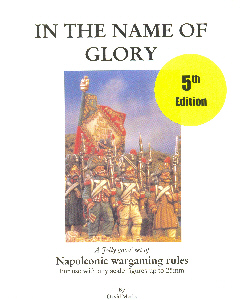|
|
|||||||||||||||
|
|
|||||||||||||||
 |
|||||||||||||||
 |
|
What’s Cooking? The first question about a new edition is usually “What’s Different?” In this case, quite a lot, actually. In The Name Of Glory (ITNOG) is a grand tactical rules set designed for players seeking a game of moderate complexity. The basic unit is a brigade, comprised of four stands. It uses a card activation system, with a few twists (see below). But players always has fewer cards than units (ain’t that always the way?). The game focuses more on morale than raw strength, and in fact units and combat effects are measured in morale points, rather than strength points. While units pretty much obey the player’s wishes, the card system makes for a very dynamic and unpredictable turn sequence.
List Of Ingredients
ITNOG comes as a 94 page book with a spiral binding and two player aid cards on card stock (despite what the back cover says, these are not laminated). There is a dash of color on the inside, with small pictures of beautifully painted 28 mm figures through out. The rules run 56 pages, followed by seven of optional rules. Also included are: Players will need to make a variety of counters or markers to play the game, or else develop paper rosters if they prefer. How Big? How Many? How Long? ITNOG uses the same game scales for all figures except 2 mm (in which case they are halved). The ground scale is 1 mm = 2 yards. Turns do not represent specific periods of time, though if you need a scale, 20 minutes is suggested. As there is no figure removal (casualties are taken in complete stands) players may use any scale figure, in any figure ratio they like. Using the suggested 15 mm basing, a brigade would be made up of 16 figures with an approximate figure ratio of 1:150. One interesting twist is that a unit may move as many times as it can be activated, so Basing, Braising, and Roasting: How To
As should be clear, ITNOG has no specific figure ratios. Therefore the basing is not critical. The important points are that (a) both sides need to be based the same and (b) brigades should be comprised of four stands. You can even use the 3” squares from Grande Armee or Volley & Bayonet, using “formation” markers. However, if you need a basing system, the author provides some recommended base sizes. Here are the basic base sizes for 10-15 mm figures: Which Comes First, Cheese or Salad? One nice thing about the activation rules is they do away with the programmed turn sequence. As each unit is activated it may move, fire, charge, join a melee or perform any other action. Thus, you may activate a unit and move it, then move it again, then activate it a third time (assuming you’ve got the cards to do so) and have it fire or charge an enemy unit. Once activated, each action requires uses some of a unit’s movement allowance for that activation. A unit may perform any combination of actions provided it does not exceed its movement allowance. Once a player has activated as many units as he can with the cards in his hand (he need not activate any) his turn is over and his opponent repeats the process. At the end of each turn, players draw cards from the unused portion of their deck and “refill” their hand. The Gourmet Touch While many of the game mechanics will be relatively familiar to most war gamers (or anyone who has read a lot of rules sets, whether or not he has ever played) there are a few twists here and there. The Activation System: The activation system is the major addition to the game for the 5th edition. The 4th edition had a much more traditional turn sequence (i.e. Command Phase, Charge Phase, Movement Phase, Firing, then Melee and Rally) and players could move all, some or none of their units each turn. Now, each player gets to do a bit, then it’s the other player’s turn. Essentially the system works like this: you get one unit card for each unit in your army. That card may only be used to activate that specific unit. In addition, you get “leadership cards” which may be used to activate any unit. The base number of leadership cards is three, subject to a variety of modifiers (nationality and commander class - Napoleon, Wellington, Davout and Archduke Charles are called out, others modify the number of cards based on their rating). You shuffle the deck, and draw a hand. Your hand is limited to a percentage of the number of units in your army. Better armies get bigger hands (and are thus able to activate more units per player turn than their opponent). Better armies and commanders also get more Leadership Cards and are thus more flexible. In each turn you may activate all some or none of your units. Activation allows a unit to move, fire, charge, etc. Card management will thus be a “sub-game” of any ITNOG game. For example, you desperately need to activate your hussars but don’t have a card to do it with. So, to clear out your hand, you move three units a tad, just to “discard” their cards from your hand. Then, at the end of your turn, you can draw three new cards to fill out your hand, hoping to get a card for your hussars (of course, if something changes and now those units that moved just a tad are needed....). Combat: Fire Combat is fairly straight forward. Cross index firing unit, target type and range and get a base “to hit” number. Add the roll of a d6. This is your “to hit” number. Roll a d20 and if you roll under your to hit number you cause the target to lose one or more MP’s (morale points). Artillery and musketry uses the exact same mechanic, just using separate charts. Note: Musketry may be effective up to 18 cm or 360 yards on the ground. Obviously hits are harder to obtain, and do only 1 MP per hit. The fire tables neatly account for firing troop quality, range, terrain, and target formation. See the table here. Morale: One side of the player aid chart is the morale chart. For each morale check, you add the unit’s MP rating, add bonuses for attached leaders, then add the roll of two d6. This is your morale factor. To test morale you roll a d20, hoping to roll equal to or below your morale factor. If you fail, you roll a d20 and suffer one of three possible effects. These are quite varied depending on what caused the morale check to begin with. You may fail to charge, you may rout, you may withdraw. Melee: The melee rules here allow for “supporting” units. In essence, if brigade A is in base-to-base contact with brigade B, brigade B may support brigade A in melee. This allows both units to fight as one (almost) in a melee. Melee is similar to fire combat, but is based on Morale Factors, like a morale check. One note about flanks in ITNOG: for charge and melee purposes a flank attack is not possible if a flank is considered supported. In this game, that means if a friendly unit is within 15 cm of the flank, or if there are certain kinds of terrain within 15 cm (the edge of the table does not secure a flank). Destroying Terrain: One touch I really liked are rule provided for using fire combat to destroy cover. Now you can use your heavies to remove that wall... The Good, the Bad, and the Incomprehensible: In general I found the rules fairly easy to read. Main points were often repeated, and specific text was reused which I found help things sink in. But these are not a set to use with a rules lawyer in the house. They clearly call for friendly opponents, and mutual common sense. There are also a few areas that could use some stricter language. The new turn sequence needs some work. The term “turn” is used to mean both a player’s turn and a unit’s activation. Thus I was confused at first. On the one hand it mentioned moving multiple times in a turn, on the other that units cannot exceed their movement allowance in a turn. In essence, a unit gets 100% of its movement allowance each time it is activated. using clearer terminology would have helped. Likewise, the issue of figure removal / stand removal is never explicitly covered. On my first reading, I couldn’t figure out how MP’s are tracked (there are counters you put on the unit to do this, though you could easily use a roster). It would be nice if there were a clear statement like: “Until a unit is reduced to 0 MPs, it retains all of its stands.” The section on the “hand” was also not well written. The rule states The number of cards that a player may draw from their combat deck and maintain in their hand throughout the game is based on the following percentages. But the rule never explains percentage of what. Fortunately an example explains “percentage of the total number of infantry brigades, cavalry brigades and artillery stands.” But as the percentages are based on nationality and time frame, it also fails to explain how to calculate the percentages for mixed forces. Nor do the rules explain how the combat deck should get shared if there are more than one player per side. (Not hard to work something out on your own, but still...) Finally, I was disappointed in the examples. Very few are accompanied by diagrams, and many feel incomplete. The musket fire example illustrates how to sue the chart to calculate the “to-hit” number, but ends there. I think it should follow through to having a “to-hit” die roll, and explanation of the results. Here is the example in full: Example - How to use the Musket Firing table: An Austrian line unit fires muskets at extreme range at an advancing French Imperial Guard unit (8 MPs) which is in column, but has lost all commanders. The Austrian unit (4 MPs) has a brigade commander (+1 MP command bonus) in base contact making a total of 5 MPs. The Austrian unit is in line formation behind informal cover (say a hedge). The Austrian player first looks at the ‘firing unit’ section of the musket fire table. The unit is classed as ‘others.’ Looking along this row go to the 5,6 column as the unit has 5 MPs. Look down this column and start at line formation. Now look at the Target column, using the ‘Inf Column’ column. Look down this column and use the extreme Range (X) column. By cross referencing the relevant section of the FIRING UNIT column with the appropriate TARGET column, as detailed above, the figure 11 is obtained. Repeating this process for the Guard unit, the figure 5 is obtained. The example then ends. Nor is there a complete example anywhere else. The example, in my mind, should then have postulated the roll of a d6 to get a to hit number, provided a d20 roll, and explained the results. There are quite a few example similar to this in melee and else where. Not fatal, but the rules definitely have room for improvement here. All in all, I think there’s perhaps a very good set of rules here, that just need a little polishing to make them easier to understand with just one read through. I have been looking for a good set of Napoleonics rules for conventions, and ITNOG may be it. I’m going to try a solo replay of the one scenario provided, adn will post a game report here inthe next week or two. Where to Get Help If the Smoke Alarm Goes Off
Home Page: None (see below). Support: Dave Marks, the author, is a frequent visitor to his Yahoo group. Links & Resources: Back to the Blue Rules Revue.... Have something to add? Want to reply, clarify, disagree? E-mail me! This page last updated May 18, 2005. |
 |
|||
|
|
|||
